Life at the Lake
a diary of living at a small lowland lakeWHAT IT'S LIKE
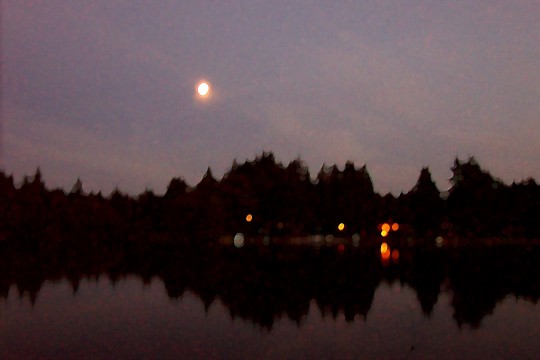
Early moonrise over Lake Ketchum
|
Archive Search |
| Links |
|
and s-integrator |

White head and tail mark the American bald eagle
Yesterday, while fishing off my dock for trout, I spotted a dead fish on my shoreline. It floated belly-up among some green algae and weeds. From the looks of its orange pectoral fins, I thought it was a yellow perch, but to make sure I hauled it in with my seldom-used fish net.
Sure enough, a perch; badly bloated, it had been dead for several days. Now that I had it, confirmed it, I needed to get rid of it. I emptied the net into the deeper water at the end of the dock, depending on the gentle Westward current to carry it away. Then I returned to my fishing.
Quickly I had a strike. While I played the small trout, a shadow passed overhead. It was so large I flinched. At first I thought it was an osprey, but, no, it was a mature bald eagle, with brilliant white tail and head.
How unusual, I thought. Usually an eagle is sighted high up in the sky, or else almost invisible perched in a tall cedar across the lake. Then it dawned on me what had happened.
The eagle had been perched somewhere nearby, perhaps across the lake, and had seen the perch floating on the surface. (Perhaps the great bird had even seen me deposit the fish in the lake.) Then it had . . . struck; it had flapped over and grasped the fish in its mighty talons without even seeming to strike the water.
Long ago, sports fishing for salmon in Alaska, I had seen eagles routinely do this with bloated bottom fish we had inadvertently caught and thrown back.
At annual meetings of the county lake monitors each year people had proudly reported newly resident eagles. I had none to tell them about, but eagles from nearby roosts often visited our waters. We had no nests on the lake itself.
Yes, but this was the next best things, and for a brief moment I had luckily participated in the event.
- - Comments ()
...

Sumi drawing by the Learner
When the Dalai Lama recently visited the U.S., he was asked by a reporter whether he—if he were an American citizen—would protest the up-coming invasion of Iraq, replied, "Why? The decision has already been made."
This attitude may seem cynical to many of us, but to a Buddhist it in involves deep commitment to the basic tenets of his belief and a means of living in a troubled world. The Dalai Lama is the living incarnation of the bodhisattva of compassion. He is also saying, there is the world and then there is eternity.
Many loyal Americans assembled and protested, often violently, the decision to attack, not realizing that their efforts were futile: the decision had been made, and made again in Congress. Aircraft carriers, troops, weapons, had all been assembled and were being moved to the Middle East. Sure, the invasion could have been called off, but practical common sense said there was no likelihood.
Should we all submit to the inevitable? The cosmic answer would be, Yes. All of which takes me back to the gritty world of business.
Once I was the editor of an engineering magazine that went all over the world. We printed five thousand copies on glossy paper. It emanated from the University of Washington and its college of engineering. It was largely a luxury and was read by only a few engineers or engineering educators, but had been subsidized by the state for decades; we celebrated its twenty-fifth, or silver, anniversary while I was at the helm. I loved the job—the writing, the editing, the photography involved (mine), the graphics and layout. I whistled while I worked.
Budget cutbacks in state-funded research hit the college hard, and first they let go its assistant director for research. Then it was the highly visible magazine, The Trend Engineering. The decision to do this was made by committee of deans, but mainly by the dean himself—the very man who had seen the journal into being and had given it its name.
(He was pretty witty for an engineer and later remarked that Trend sounded very much a dish detergent. He was a great guy and I respected him and his practical intelligence a lot.)
Dean Hill gave me the news at a regular meeting of the publications committee. I was indignant. I was the magazine and the decision to stop publication, and save a lot of money that could well be used for student scholarships, was a rejection of my personal self. So I protested. I protested vehemently. I argued. I argued up and down.
What I didn't understand was that the decision had already been made. They weren't asking me for an opinion or "input." They were informing me. And the dean knew that I didn't understand, or else he knew even more: that I needed and was due my little dramatic moment. So he kindly let me rave on.
My job was not on the line, only the magazine, a quarterly. They had other duties I could continue to perform; they might soon be expanded. But, no, I was a Magazine Editor, damn it. So I resigned and gave them minimal notice.
The dean understood. He threw me a nice coffee and cake party in his chambers. I considered not attending, this ex-magazine editor, now considering a new career as a freelance writer, which in many instances is a euphemism for being unemployed. But I went. I even mildly enjoyed it and the attention.
Oh, had I been as wise, as practical, as the Dalai Lama. It was useless to protest, though it was emotionally satisfying, I guess. Up to a point.
I should have nodded my head sagely, at that publications meeting, touched my fingertips together, lowered my eyes, and smiled. I should have smiled benevolently.
Instead, I slunk away to an infinitely better, greatly rewarding life. If I were a Buddhist, I would say, "Thank you, Buddha. You are always right."
- - Comments ()
...
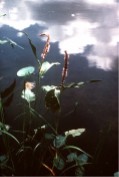
Water Smartweed, a common sight along the shore
All along my shoreline blooms this waterweed. It extends about six feet out into the shallows. I never knew its name, but when it became too persuasive (invasive?), I would wade into the shallows and pull it out by the yard.
It's not that I disliked it; it's only that there was so much of it. I'd toss it over my head, past the buffer of tall grasses, and either I or my wife would collect it from the lawn and lug it to the compost heap for the future use of the vegetable and flower beds.
This year I've learned its name. "Smart," is it? "Okay. Smart it is. It's not unpretty, I have to admit. And I called it incorrectly by the wrong name for more than a year: curly-leafed pondweed, I said. Well, it looked like that in one of my plant books. I am frequently wrong.
But a visitor from the county's surface water utility's lake group told me different. Actually, Heidi didn't know its true name, either, but she took a sample back to the office and her boss, Gene Williams, recognized it at once as a common native plant that has, unfortunately, a tendency to proliferate. So I looked it up with Goggle on the Web.
I see it now and call it by name. "Hi, there, Smartweed. Say something clever, will you?" But it remains mum. Even if I tell it that its continued existence—that is, its very life—is based on its reported cleverness, it just lies there, lightly rooted, its long wavy leaves floating on the surface.
I am beginning to like it, seriously. I don't want to take its life wantonly. And doing so is a heck of a lot of work. I have to bend over for hours and pull, pull, pull. And then my back aches. So maybe this year Smartweed and I will coexist. I will call for a mutual truce.
"Mutual?" Yes. I won't pull it and will ask it in return not to grow so abundantly. And perhaps the very few of the remaining black crappie in the lake will spawn there, and their numbers (along with the Smartweed) will slowly increase.
Such is my hope, this morning.
- - Comments ()
...
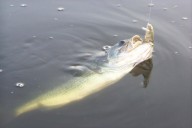
Bass from under my dock, another year
My friend Gary, from nearby Wilderness Ridge, fishes the lake often, usually for bass (which are complicated fish), but sometimes with his kids for trout. So, yesterday, I spotted him, and he motored up and dropped anchor and we talked a while.
He fishes about five rods but, of course, only one at a time, the others rigged with various bass lures—plastic worm, crankbait, diving plug, jig, etc. He reported taking one small bass, which he released. He releases all his bass. but when he and his daughter caught, on two consecutive days, two big holdover trout, he kept them for the table, and pronounced them excellent.
They had no developing spawn in them, he said. This means, in spite of their being no place to spawn, they must have jettisoned their milt and roe. Or absorbed it into the body cavity. Which shoots my theory of them dying at a certain age, when they can't spawn, all to hell.
I've taken three big fish in the past couple of weeks. (These are trout in the 15- to 21-inch range.) The first two were bright—what steelheaders call "chrome." The last was a dark fish, with paprika coloring and a wide rainbow stripe down its side, an obvious male and probably unspawned.
All of which adds to the perennial mystery. What happens to the fish in the spring of the following year after they have been planted and made such excellent growth? Beats me. My male was my thirteenth such fish. Not a huge number, but—remember—there were dozens of smaller, this-year's-plant trout I caught and released.
Gary reported seeing "clouds" of bass fry newly emergent in the shallows. Our large-mouth bass are so prolific. And these fish grow rapidly, too, but will disappear over the winter.
Food for our diving ducks, I reckon.
- - Comments ()
...
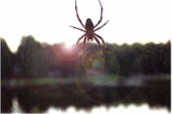
Spider at my window
The New York Summer Writers Institute at Skidmore College in Saratoga Springs, New York, is looking for students in July. It advertises a faculty of Banks, Beattie, Bidart, Forche, Ford, Kennedy, Lopate, McInerney, Moody, Ondaatje, Oates, and Pinsky—no first names, but judging by the last some of America's foremost writers.
No costs are listed in the ad, but you can bet your allowance, Bunkie, it won't be cheap, with board and room additional, and all those high-flyers to pay. So why I am I bothering to mention it in today's blog? Because it lists its workshops as fiction, poetry, and—dig this!—memoir.
"Memoir," my fellow Blogsters, has now made it to the approved list of literary genres. It ranks right up there with fiction and poetry. (What, no non-fiction?)
Never mind. We are happy—even delighted—to be included in such fine company.
But—seriously, folks—the Art of the Memoir seems more and more to be an acceptable means of high-faluting communication. Not only do Mean Scribes do it, but the classy faculty of this summer's writers institute teach it and, we can presume, have some first-hand experience at producing it.
Blogsters All!
- - Comments ()
...
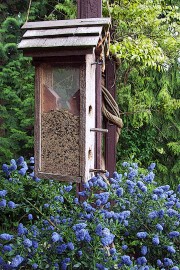
Ceanothus at the Feeder
The blue flowers so pungently in bloom now are Ceanothus, my gardner wife tells me. Its family is Rhamnacae, she adds. It lies outside the downstairs family room, where my workspace is, and its odor comes drifting in my open door, when the weather is warm.
Pretty enough, it smells like sperm. On a muggy day, it is as though you've plunged your head beneath the covers after making love. Phew. I guess some people might like it. I don't.
The rest of the year, though, it is a dark green bush with no odor to it, or no noticeable one, and the birds dart in and out of it on their way to the handy feeder, which only attracts perching birds, such as juncos, chickadees, sparrows, and this year's favorite, the rosy finch.
A couple of days ago a finch came through the open door and into my work area. There it became quickly and hopelessly lost. It found a window, unfortunately closed, and threw itself repeatedly against the glass, thrashing there. My two black Labs became quite excited at the intruder and went after it, but (in the manner of Labs) were quickly confused. So was I.
Suddenly a bright idea hit me. I ran to the boat and the seldom-used long-handled fish net. After several futile attempts I got the poor bird into it without pinning him or hitting him with the net's metal hoop. He fluttered there as I hastened out the opened door.
How would I release him? Reach in and hand-bail him out?
The bird answered my question for me. He flew out much easier than he was swooped in, and disappeared into the gathering afternoon.
Soon the stench of the neighboring Ceanothus will be gone, I know. I won't miss it.
- - Comments ()
...
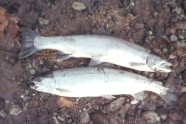
Hatchery steelhead, not sockeyes, and just a little bigger
FRESH FISH, ANYONE?
Newspaper ads for Copper River Sockeye Salmon are appearing in the local newspapers. Fillets go for $9.98 a pound at Fred Meyer, a couple of dollars less for whole fish without their heads.
This of course is highway robbery. It is pretty good fresh fish, flown in from South East Alaska, but that is a whole lot of money for fish. And sockeye is oily and orange, which is highly desirable. It is the species that cans well, appears in great abundance, and ordinarily is cheap. But advertising promotions have jacked up the price unconscionably.
All of which takes me back to my experiences, nearly fifty years ago, fishing for these same fish in the same river, Alaska's Copper. Little had I known. . . .
We were GIs, stationed at Tonsina, Alaska, constructing a telephone pole line. We worked six days a week. On the seventh day we relaxed. Three of us took a jeep and rode the fifty-mile dirt road into Chitna, which was not even a town. It was near the Copper River.
In summer the river ran clay-colored, with only a foot of visibility. But even then, in early summer, it was full of invisible sockeye; we could see them splashing as they ascended. There were thousands.
Local Indians had a fishery and sold some of their fish, though many were for their own consumption. They fished with long-handed dipnets, much as other tribes fished the Columbia for Chinook near The Dalles Dam.
The Chitna-based Alaskan tribes left their dipnets at the site, securing them there with a chain and padlock. We soldiers saw the nets, the splashing salmon and—putting two and two together—decided to "liberate" the nets for an hour or so. To do this, we had to smash the padlock with a rock. This took repeated blows but eventually worked.
We went to the high-bank portion of the river and plunged our nets into the gray caldron, sweeping along and up the current, with a lifting motion. How easy it was. A single sweep of the net would capture at least three sockeyes. They were shiny bright and weighed from three to five pounds, I'd say. Small for salmon, but that is how sockeyes are.
When we'd had our fill of fishing, we took our catch and stuck them head-first into pails and loaded them in the back of the jeep. (It was a strange, modified vehicle, with a gear-shift that was so worn that it operated independently of the clutch.) When it was time to return to our base camp, we neatly put the nets alongside where we had found them and actually ran the chain back through their hoops. We put the ruined lock where it had been.
We headed back to Tonsina. I rode in back with the pails of fish. As I said, it was a dirt road, with many a chuckhole, and each time a wheel hit a pit the pails bounced and the slimy fish flipped out. My job, for that returning fifty miles, was to put the fish back, head-first, into the pail out of which they had bounced or been bumped. By the time we reached the lodge, my shirt and face and arms were covered with slime and loose scales.
What we did with the fish I don't remember. Probably turned our proud catch over to the cook at the lodge, where we were fed and quartered.
"Ten dollars a pound, filleted?" We would not have believed it.
Still don't.
- - Comments ()
...